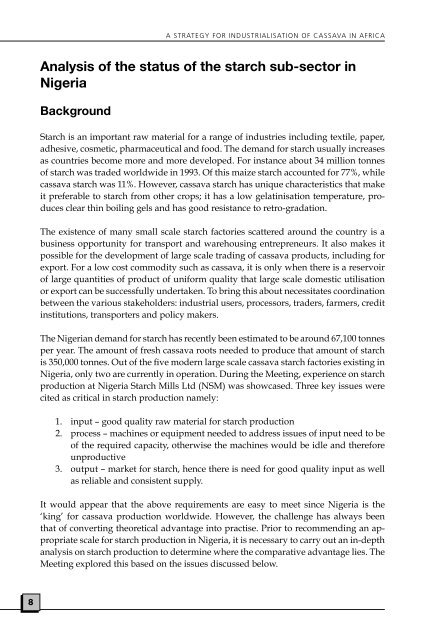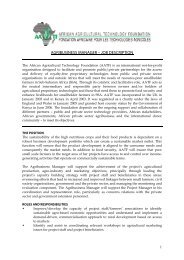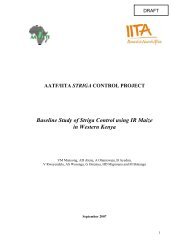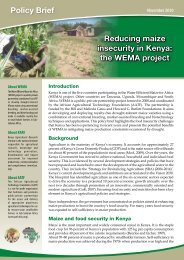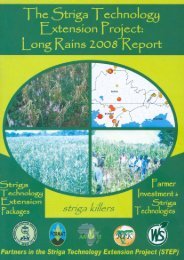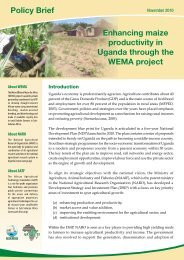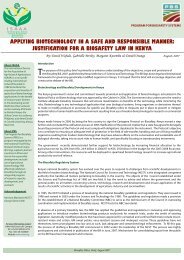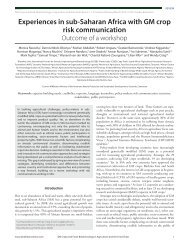A strategy for industrialisation of cassava in Africa - African ...
A strategy for industrialisation of cassava in Africa - African ...
A strategy for industrialisation of cassava in Africa - African ...
Create successful ePaper yourself
Turn your PDF publications into a flip-book with our unique Google optimized e-Paper software.
A STRATEGY FOR INDUSTRIALISATION OF CASSAVA IN AFRICA<br />
Analysis <strong>of</strong> the status <strong>of</strong> the starch sub-sector <strong>in</strong><br />
Nigeria<br />
Background<br />
Starch is an important raw material <strong>for</strong> a range <strong>of</strong> <strong>in</strong>dustries <strong>in</strong>clud<strong>in</strong>g textile, paper,<br />
adhesive, cosmetic, pharmaceutical and food. The demand <strong>for</strong> starch usually <strong>in</strong>creases<br />
as countries become more and more developed. For <strong>in</strong>stance about 34 million tonnes<br />
<strong>of</strong> starch was traded worldwide <strong>in</strong> 1993. Of this maize starch accounted <strong>for</strong> 77%, while<br />
<strong>cassava</strong> starch was 11%. However, <strong>cassava</strong> starch has unique characteristics that make<br />
it preferable to starch from other crops; it has a low gelat<strong>in</strong>isation temperature, produces<br />
clear th<strong>in</strong> boil<strong>in</strong>g gels and has good resistance to retro-gradation.<br />
The existence <strong>of</strong> many small scale starch factories scattered around the country is a<br />
bus<strong>in</strong>ess opportunity <strong>for</strong> transport and warehous<strong>in</strong>g entrepreneurs. It also makes it<br />
possible <strong>for</strong> the development <strong>of</strong> large scale trad<strong>in</strong>g <strong>of</strong> <strong>cassava</strong> products, <strong>in</strong>clud<strong>in</strong>g <strong>for</strong><br />
export. For a low cost commodity such as <strong>cassava</strong>, it is only when there is a reservoir<br />
<strong>of</strong> large quantities <strong>of</strong> product <strong>of</strong> uni<strong>for</strong>m quality that large scale domestic utilisation<br />
or export can be successfully undertaken. To br<strong>in</strong>g this about necessitates coord<strong>in</strong>ation<br />
between the various stakeholders: <strong>in</strong>dustrial users, processors, traders, farmers, credit<br />
<strong>in</strong>stitutions, transporters and policy makers.<br />
The Nigerian demand <strong>for</strong> starch has recently been estimated to be around 67,100 tonnes<br />
per year. The amount <strong>of</strong> fresh <strong>cassava</strong> roots needed to produce that amount <strong>of</strong> starch<br />
is 350,000 tonnes. Out <strong>of</strong> the five modern large scale <strong>cassava</strong> starch factories exist<strong>in</strong>g <strong>in</strong><br />
Nigeria, only two are currently <strong>in</strong> operation. Dur<strong>in</strong>g the Meet<strong>in</strong>g, experience on starch<br />
production at Nigeria Starch Mills Ltd (NSM) was showcased. Three key issues were<br />
cited as critical <strong>in</strong> starch production namely:<br />
1. <strong>in</strong>put – good quality raw material <strong>for</strong> starch production<br />
2. process – mach<strong>in</strong>es or equipment needed to address issues <strong>of</strong> <strong>in</strong>put need to be<br />
<strong>of</strong> the required capacity, otherwise the mach<strong>in</strong>es would be idle and there<strong>for</strong>e<br />
unproductive<br />
3. output – market <strong>for</strong> starch, hence there is need <strong>for</strong> good quality <strong>in</strong>put as well<br />
as reliable and consistent supply.<br />
It would appear that the above requirements are easy to meet s<strong>in</strong>ce Nigeria is the<br />
‘k<strong>in</strong>g’ <strong>for</strong> <strong>cassava</strong> production worldwide. However, the challenge has always been<br />
that <strong>of</strong> convert<strong>in</strong>g theoretical advantage <strong>in</strong>to practise. Prior to recommend<strong>in</strong>g an appropriate<br />
scale <strong>for</strong> starch production <strong>in</strong> Nigeria, it is necessary to carry out an <strong>in</strong>-depth<br />
analysis on starch production to determ<strong>in</strong>e where the comparative advantage lies. The<br />
Meet<strong>in</strong>g explored this based on the issues discussed below.<br />
8


